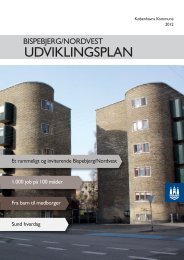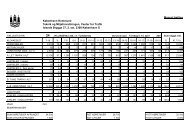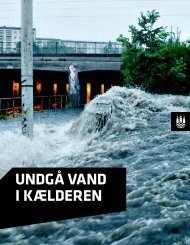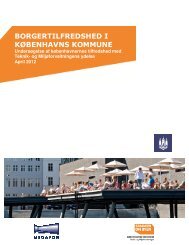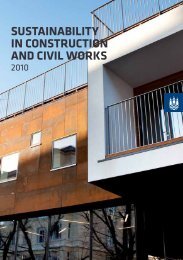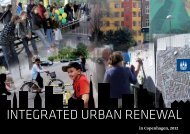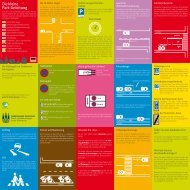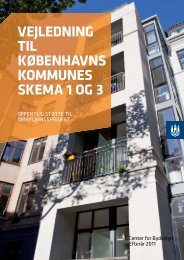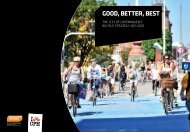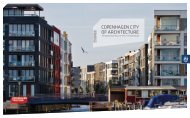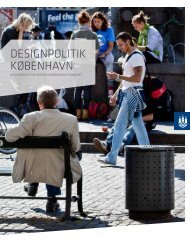ECO-METROPOLIS OUR VISION FOR COPENHAGEN 2015 - Itera
ECO-METROPOLIS OUR VISION FOR COPENHAGEN 2015 - Itera
ECO-METROPOLIS OUR VISION FOR COPENHAGEN 2015 - Itera
You also want an ePaper? Increase the reach of your titles
YUMPU automatically turns print PDFs into web optimized ePapers that Google loves.
<strong>ECO</strong>-<strong>METROPOLIS</strong><br />
<strong>OUR</strong> <strong>VISION</strong><br />
<strong>FOR</strong> <strong>COPENHAGEN</strong> <strong>2015</strong>
IN <strong>2015</strong> <strong>COPENHAGEN</strong> WILL BE RIGHTLY<br />
KNOWN AS THE CAPITAL CITY IN THE WORLD<br />
WITH THE BEST URBAN ENVIRONMENT.<br />
<strong>COPENHAGEN</strong> WILL HAVE B<strong>ECO</strong>ME THE<br />
<strong>ECO</strong>-<strong>METROPOLIS</strong> OF THE WORLD,<br />
THUS DEMONSTRATING THAT<br />
ENVIRONMENTAL CONCERN ADDS AN<br />
EXTRA DYNAMIC TO URBAN DEVELOPMENT.<br />
<strong>COPENHAGEN</strong>ERS AND VISITING GUESTS<br />
WILL BE ABLE TO SEE AND APPRECIATE THE<br />
IMPROVEMENTS, WHILE AT THE SAME TIME THE<br />
CITY WILL BE SHARING ACTIVE RESPONSIBILITY<br />
<strong>FOR</strong> GLOBAL ENVIRONMENTAL DEVELOPMENT.
<strong>OUR</strong> <strong>VISION</strong><br />
In 2007, Copenhagen has already defined itself as the<br />
environmental capital of Europe. With this environmental<br />
initiative, Copenhagen will show global leadership<br />
in the environmental field. This is an imperative for good<br />
quality of life, for future generations and for the survival<br />
of the animal kingdom. And also because Copenhagen<br />
can create a global difference by paving the way.<br />
We are setting a long-term goal for development until<br />
<strong>2015</strong> because we would like Copenhagen to be an inspirational<br />
example. Copenhagen will demonstrate to other<br />
capitals how a greener urban environment can enhance<br />
the quality of life in practical terms. This will be to the<br />
advantage of the citizens both of our city and the world.<br />
This will also be to the advantage of current and future<br />
generations.<br />
Copenhagen will be at the forefront of all major cities in<br />
terms of environmental initiatives in all areas. More than<br />
ever before, the environment will be pivotal for Copenhagen’s<br />
culture, urban life and identity.<br />
The visions and goals of the Eco-metropolis will be included<br />
and specified in the City’s other work, e.g. the Municipal<br />
Plan and the Agenda 21 Plan.<br />
Copenhageners will be proud to live in their city because<br />
they value a good environment in Copenhagen and globally,<br />
and because they can see that they and their city are<br />
both contributing to it. Everyone can contribute, on a large<br />
scale or a small one. Everyone who makes a difference will<br />
be recognised for it.<br />
Copenhagen will be a capital city which attracts business<br />
life because companies and their staff will be keen to be<br />
part of an environmental success in a growth area.<br />
The world will come to Copenhagen to see how to create<br />
modern environmental policies in the 21st century. Copenhagen<br />
will become a capital where visitors to the city experience<br />
a green and safe urban environment, returning home<br />
with an understanding of how environmental concerns can,<br />
in practice, support a dynamic urban development.<br />
Copenhagen will be a major city which lives and<br />
breathes because of its concern for the environment, not<br />
in spite of it. The City will lead the way and its citizens<br />
will contribute actively to improving the environment<br />
through their daily activities.<br />
We will rethink environmental policy, make Copenhagen<br />
an even better place to live and place Eco-metropolis<br />
Copenhagen on the world map.<br />
That is our vision.<br />
City of Copenhagen, 2007
WE HAVE SET NEW AMBITIOUS AND BINDING<br />
GOALS <strong>FOR</strong> <strong>2015</strong>; WE WILL SUPPORT <strong>OUR</strong><br />
WORDS WITH ACTIONS; WE WILL ACHIEVE<br />
THOSE GOALS THROUGH CONCRETE AND<br />
VISIBLE INITIATIVES.
ACTION<br />
Visions require actions to become reality. Copenhagen<br />
has already demonstrated its capacity to back<br />
up its words with actions. Copenhagen is a city at a very<br />
positive developmental stage. Economic growth has been<br />
followed by local urban renewal in certain localities and<br />
even the creation of whole new districts. At the same<br />
time, Copenhagen is a leading city in the environmental<br />
field: Copenhageners are among the most environmentally<br />
conscious citizens in the whole world. Development and<br />
the environment go hand in hand.<br />
quantities of organic food stuffs. If anbody had said ten<br />
years ago that it would be possible today to swim – or<br />
fish for cod – in Copenhagen Harbour, most people<br />
would have shaken their head in disbelief!<br />
Ambitious visions demand ambitious actions; but we have<br />
an excellent starting point. This is not the first time Copenhagen<br />
has taken the lead but we must now advance<br />
with even more determination for the benefit of both the<br />
population and the environment.<br />
Copenhagen is well-known for the windturbines on<br />
Middel grund, an area just outside the harbour of Copenhagen.<br />
We have one of the biggest district heating<br />
systems in the world: 97 % of households are connected<br />
to it. Surplus heat produced when generating electricity is<br />
reused for heating instead of being ejected into the sea.<br />
Energy is thus used twice and CO 2<br />
emissions are reduced.<br />
Since the 1990s we have had one of the world’s best<br />
waste management systems. Today, we reuse about 90 %<br />
of all building waste and incinerate about 75 % of household<br />
waste. The energy from burning waste material is<br />
used for electricity and district heating. This system is<br />
now being worldwide copied.<br />
In spite of strong economic growth, we have succeeded<br />
in keeping water and energy consumption at a constant<br />
level. We protect our drinking water and buy increasing<br />
Before 2010, the City of Copenhagen will have taken decisions<br />
about at least ten Star Initiatives. By this we mean<br />
highly visible, pivotal and concrete improvements affecting<br />
the environment of Copenhagen.<br />
Large-scale environmental initiatives are not new in<br />
Copenhagen. For example, we have recently decided to allocate<br />
DKK 185 million over a four-year period to improve<br />
conditions for cyclists. Some years ago, we opened the<br />
first swimming pool in the harbour.<br />
The new aspect of this is that we will significantly intensify<br />
our efforts for more and better environmental initiatives.<br />
The Star Initiatives will at the same time be supported<br />
by a broad spectrum of concrete and effective ’down-toearth’<br />
projects, including in the forthcoming Agenda 21<br />
plan for the period 2008-2012.
<strong>OUR</strong> <strong>VISION</strong> HAS<br />
F<strong>OUR</strong> THEMES <strong>FOR</strong><br />
<strong>ECO</strong>-<strong>METROPOLIS</strong><br />
<strong>COPENHAGEN</strong>:<br />
WORLD’S BEST CITY<br />
<strong>FOR</strong> CYCLES<br />
CLIMATE CAPITAL<br />
A GREEN AND BLUE<br />
CAPITAL CITY<br />
A CLEAN AND<br />
HEALTHY BIG CITY<br />
The work in the coming years will be both measurable and<br />
goal-oriented.<br />
The City of Copenhagen will lead the way but without<br />
active input from the citizens and business sector, it will be<br />
impossible to achieve our vision. For this reason, we will involve<br />
the citizens and business sector in our environmental<br />
policy and focus on educating people about environmental<br />
and climate matters in such a way as to make it easier and<br />
more attractive to engage with the environment on a daily<br />
basis.<br />
We will look beyond our municipal borders. Copenhagen<br />
will increasingly influence national and international agendas.<br />
We will work to ensure that challenges and barriers<br />
the City cannot overcome alone will be debated in the<br />
Danish Parliament, EU, UN and other national and international<br />
fora. This is necessary not only for the environment in<br />
Copenhagen but also for the global environment.<br />
Copenhagen will also ensure that experience gained during<br />
the municipality’s ambitious environmental work will<br />
be shared both nationally and internationally. Similarly,<br />
Copenhagen will cooperate in a more goal-oriented way<br />
with other municipalities, major cities and regions than has<br />
been the case in the past. The more major cities striving to<br />
achieve something extraordinary for the environment, the<br />
better.
THE WORLD’S BEST CITY <strong>FOR</strong> CYCLES<br />
<strong>COPENHAGEN</strong> WILL<br />
B<strong>ECO</strong>ME THE WORLD’S<br />
BEST CITY <strong>FOR</strong> CYCLES.<br />
NOT ONLY WILL PEOPLE BE<br />
ABLE TO CYCLE QUICKLY<br />
TO THEIR DESTINATION<br />
BUT ABOVE ALL SAFELY.<br />
Currently, cyclists in Copenhagen are biking more<br />
than 1.1million km – every day! 36 % of Copenhageners<br />
choose to go by bike to their place of<br />
work or educational institution. This amazing number<br />
of cycles is presumably a world record and constitutes<br />
an important part of Copenhagen’s identity.<br />
Our cycle culture has evolved and developed over<br />
many years, helped by ongoing investments in cycle<br />
tracks, cycle routes and so on. Many Copenhageners<br />
want more and broader cycle tracks, more green cycle<br />
routes free from car traffic, green waves between<br />
traffic lights and better cycle-parking facilities, also<br />
at their workplaces.<br />
During recent years, we have built a new bridge<br />
over the harbour for cyclists and pedestrians. A<br />
similar one is under construction over Ågade. Many<br />
new cycle-parking stands have been set up and several<br />
campaigns have contributed to better and safer<br />
cycle-traffic. The initiative will continue and will<br />
be intensified. Conditions for cyclists will improve<br />
further, so that even more people will choose<br />
to transform the journey to their place of work<br />
or education into a bike ride in Eco-metropolis<br />
Copenhagen.<br />
Cyclists already contribute to holding down CO 2<br />
emisisions from traffic compared to other major<br />
cities. When we achieve our goal of 50 % of Copenhageners<br />
cycling to work, we will reduce CO 2<br />
emisisions by a further 80,000 tonnes per year in<br />
the traffic of Copenhagen.<br />
We would like the new cyclists to be car drivers<br />
discovering the many advantages of cycling: no<br />
time wasted in traffic jams, better health, less CO 2<br />
emissions and cheaper transport. The best alternative<br />
to cycling will be public transport, which must<br />
also be improved. Investments in ease of travel by<br />
metro, bus and so on will ensure that public transport<br />
is the preferred alternative to cycling, rather<br />
than the car.
It is also important to feel safe and secure when<br />
you take your bike, especially for young cyclists and<br />
their parents. During the last few years the number<br />
of accidents has fallen but nearly half the serious<br />
traffic injuries, for example concussion or broken<br />
bones, are cyclists. Something must be done about<br />
this. As a minimum, we must halve the number of<br />
seriously injured cyclists.<br />
Copenhagen takes the yellow jersey and the<br />
world’s capitals can draw inspiration from<br />
the world’s best city of cyclists!<br />
GOALS <strong>FOR</strong> <strong>2015</strong><br />
<br />
<br />
<br />
IN <strong>COPENHAGEN</strong> AT LEAST 50 % OF<br />
PEOPLE WILL GO TO THEIR WORK<br />
PLACE OR EDUCATIONAL INSTITU-<br />
TION BY BIKE<br />
THE NUMBER OF SERIOUSLY INJURED<br />
CYCLISTS WILL DROP BY MORE THAN<br />
HALF COMPARED TO TODAY<br />
AT LEAST 80 % OF <strong>COPENHAGEN</strong><br />
CYCLISTS WILL FEEL SAFE AND SECURE<br />
IN TRAFFIC
<strong>COPENHAGEN</strong> WILL ASSUME A<br />
GLOBAL RESPONSIBILITY BY TAKING<br />
THE LEAD IN REDUCING CO 2<br />
EMISSIONS. WE WILL SHOW THE<br />
WORLD AND ESPECIALLY OTHER BIG<br />
CITIES THAT CO 2<br />
EMISSIONS CAN BE<br />
REDUCED EFFECTIVELY WITHOUT<br />
ADVERSELY AFFECTING <strong>ECO</strong>NOMIC<br />
GROWTH.
CLIMATE CAPITAL<br />
When Copenhagen hosts the UN’s climate conference<br />
in 2009, the world will be thirsty for a success<br />
story. As host city, we must make a significant effort<br />
to reduce greenhouse gas emissions.<br />
remarkable growth in the city. The fall is primarily due to<br />
connecting the district heating system and generating stations<br />
to cleaner fuels, especially the change from coal and<br />
oil to natural gas.<br />
Climate Capital Copenhagen has already taken giant steps<br />
in reducing CO 2<br />
emissions. Every citizen has reduced his<br />
input to global warming by 2.1 tonnes compared to the<br />
1990 figures, from 7 tonnes to 4.9 tonnes. This corresponds<br />
to a reduction in CO 2<br />
emissions of 25 % for every Copenhagener<br />
over 15 years of age. This has occured despite<br />
We can and must however, improve further. Vehicular CO 2<br />
emissions are increasing. Coal is still used too much to<br />
provide energy in Denmark. An intelligent climate policy<br />
will not stop the wheels turning; on the contrary. Society<br />
and citizens can make considerable savings by acting in a<br />
climate friendly way. So, we dare to set an ambitious new
goal of reducing CO 2<br />
emissions by a further 20 % by <strong>2015</strong><br />
compared to today (2005 figures). This means that by <strong>2015</strong><br />
we will have reduced emissions by 40 % compared to<br />
1990. In <strong>2015</strong>, no Copenhagener will emit more than 3.7<br />
tons of CO 2<br />
on average.<br />
The climate must become a matter of natural concern. This<br />
will give much better results than wagging a parental finger<br />
in admonition. An extra effort will therefore be made in<br />
the run up to the summit in Copenhagen in December<br />
2009, to highlight what the individual citizen in Copenhagen<br />
can do to reduce CO 2<br />
emissions.<br />
The City of Copenhagen will lead the way. For example,<br />
all new municipal buildings will be environmentally friendly.<br />
The considerable potential for energy-saving already<br />
existing in the City’s own buildings will be exploited by<br />
environmentally sensible restoration and renewal. In order<br />
to reduce the amount of car traffic, we will focus on green<br />
transport and congestion charging as well as measures to<br />
promote public transport.<br />
The City will go first with its Star Initiatives and its daily<br />
practice. The wider use of sustainable energy through the<br />
use of solar cells, geothermal energy and wind power for<br />
example, must be strongly promoted.<br />
Companies in Copenhagen must also play a more active<br />
role. They must work in harmony with leaders in the field<br />
of energy, setting goals to reduce energy use. Many new<br />
office blocks for example, use a lot of energy for cooling<br />
purposes. We will invite companies to cooperate in ensuring<br />
the correct solutions for the future.<br />
Well before the UN Conference on Climate change, the<br />
City of Copenhagen will present a coordinated climate<br />
strategy for Climate Capital Copenhagen up to the year<br />
<strong>2015</strong>.<br />
Through action, Copenhagen will be a dynamo and<br />
inspiration in the fight against climate change!<br />
GOAL <strong>FOR</strong> <strong>2015</strong><br />
THE CITY’S CO 2<br />
EMISSIONS WILL BE REDUCED BY AT LEAST 20 % COMPARED TO 2005.
A GREEN AND BLUE CAPITAL CITY<br />
IN <strong>COPENHAGEN</strong> THERE<br />
MUST BE EASY, FIRST-CLASS<br />
ACCESS TO BLUE AND<br />
GREEN RECREATIONAL<br />
AREAS OF THE HIGHEST<br />
QUALITY.<br />
Copenhageners are crazy about blue and green areas.<br />
Fælledparken (a historic central park in Copenhagen)<br />
alone is used by 11 million people each year – three<br />
times as many as Tivoli, the world-famous amusement park.<br />
After just one summer season, Amager Beachpark, located<br />
3 km away from the city centre on an island linked to the<br />
south of Copenhagen, has attracted thousands of visitors.<br />
Sea bathing has for many years been the subject of stories<br />
amongst Copenhageners and the world in general. How<br />
many capital cities can boast of having clean water in its<br />
harbour?
The city’s popular parks, beaches and sea swimming-pools<br />
are visible proof that a good environment enhances peoples’<br />
daily well-being. They send out strong messages to us<br />
city-dwellers. They offer us the chance for physical activity<br />
and development, peace and relaxation as well as the<br />
chance to experience birds and animals.<br />
Research has shown that in this way, green and blue areas<br />
can contribute decisively to city-dwellers’ health and wellbeing.<br />
Copenhageners simply feel better by visiting the<br />
park, the beach or a sea swimming-pool on a regular basis.<br />
A sustainable city is also a city in harmony with nature.<br />
The clean water in the harbour tells us that we are on the<br />
right track to develop a sustainable water system. The city’s<br />
trees, parks and natural areas combine to purify the air and<br />
create shelter. The city’s parks and natural areas contain<br />
an environment for a rich plant and animal life, thereby<br />
contributing to the city’s biological diversity. There must<br />
be a place for both animals and people in Eco-metropolis<br />
Copenhagen.<br />
We know that busy city-dwellers do not have much spare<br />
time in their daily lives. Today, every Copenhagener spends<br />
on average one hour in a park every other day. Today,<br />
60 % of Copenhageners live within 15 minutes walk of<br />
green or blue areas. This is good but it can be improved.<br />
And it will be!<br />
The initiative will cover the creation of new parks, beaches<br />
and sea swimming-pools as well as good, safe, green connections<br />
through town so it will easier to reach the blue<br />
and the green areas. We are not necessarily talking about<br />
large areas. Even small parks of about 2,000 square meters,<br />
about a fifth the size of a football pitch, are large enough<br />
for many activities and experiences. Within the most tightly<br />
packed parts of the city, where there is little room for new<br />
green areas, it is a question of improving the existing parks.<br />
The green and blue areas will bind the city<br />
together, creating good experiences for the city’s<br />
inhabitants and visitors!<br />
GOALS <strong>FOR</strong> <strong>2015</strong><br />
90 % OF <strong>COPENHAGEN</strong>ERS MUST BE<br />
ABLE TO WALK TO A PARK, A BEACH<br />
OR A SEA SWIMMING-POOL IN LESS<br />
THAN 15 MINUTES.<br />
<strong>COPENHAGEN</strong>ERS WILL VISIT THE<br />
CITY’S PARKS, NATURAL AREAS, SEA<br />
SWIMMING-POOLS AND BEACHES<br />
TWICE AS OFTEN AS THEY DO<br />
TODAY.
A CLEAN AND HEALTHY BIG CITY<br />
<strong>COPENHAGEN</strong> WILL OFFER<br />
EVERYONE ONE OF THE<br />
WORLD’S CLEANEST AND<br />
MOST HEALTHY BIG CITY<br />
ENVIRONMENTS.<br />
An even cleaner and healthier capital needs an extraordinarily<br />
broad effort. Compared to many other<br />
big cities, Copenhagen already provides a clean and healthy<br />
urban environment.<br />
The improvement of the air quality in Copenhagen is the<br />
ultimate success story. Since the 1960s, the air quality has<br />
quite simply improved continuosly. This is an excellent<br />
example of how economic growth and environmental<br />
improvement go hand in hand. Today, car traffic is by far<br />
the greatest cause of air pollution in Copenhagen.<br />
The air can and must be even cleaner than it is now. The<br />
goal is clear. People should be able to move around in<br />
Eco-metropolis Copenhagen and breathe the air without<br />
risk to their health. Like the majority of big European cities,<br />
Copenhagen has difficulty in living up to the air quality<br />
requirments for nitrous dioxide (NO 2<br />
) and large particles<br />
(PM10). By <strong>2015</strong> at the latest, we must be able to meet<br />
all the national and international limits for harmful material<br />
in the air which can be damaging to our health. The<br />
planned environment zone will contribute positively and<br />
mean fewer premature deaths. The City, however, wants<br />
to go further than the law currently allows. The environmental<br />
zone scheme must be made dynamic and it must<br />
become possible to tighten limits covering vehicles’ exhaust<br />
emissions on an ongoing basis. Congestion charging and<br />
environmentally friendly vehicles must be introduced in the<br />
City. National and international limits ensuring improved air<br />
quality should be tightened. The City will work actively to<br />
achieve these goals not least by securing support for the<br />
necessary means for achieving them.<br />
Noise must be combatted. Noise influences our childrens’<br />
ability to learn as well as everybody’s health, especially if<br />
we do not get a good night’s sleep. Despite an effort to<br />
reduce noise in residential areas, the number of dwellings<br />
subject to noise has not decreased. We do not have the figures<br />
for such affliction at night but we do know that there<br />
are 40,000 dwellings in Copenhagen which are affected by<br />
excessive traffic noise on a round-the-clock basis. Of these,<br />
5,000 dwellings are affected by a noise level which is damaging<br />
to health (over 70dB). The trend must be broken and<br />
the number of Copenhagen citizens who are most affected<br />
by noise (over 70dB) must first have this nuisance reduced.<br />
Recent research shows that noise reduces childrens’ learning<br />
ability. We will therefore work to ensure that the City’s<br />
schools and institutions are not subject to more than a<br />
low noise level (55dB). Many initiatives must be taken to<br />
achieve the goal, for example, reducing the speed limit,
egulating the traffic, laying new road surfaces and insulating<br />
dwellings and institutions.<br />
GOALS <strong>FOR</strong> <strong>2015</strong><br />
Ecology in itself benefits the environment and the health<br />
of Copenhageners. Today, about 45 % of food consumption<br />
in municipal institutions is organic. This is probably<br />
unmatched in any other capital in the world. We want to<br />
be twice as good: by <strong>2015</strong> we will have doubled this figure<br />
to 90 %. At the same time, we are working to increase the<br />
percentage of organic food eaten throughout the capital<br />
from a current national figure of about 7 % to at least<br />
20 %. This will be a world record. We are also working on<br />
increasing the nutritiousness of the food as well as its taste.<br />
Copenhagen will also become one of the cleanest capitals<br />
in the world. Benches, playgrounds and street equipment<br />
must not be worn or out of repair. The streets must not<br />
be pot-holed. A run-down city gives an untidy impression<br />
and tends to lead to more vandalism and garbage on the<br />
streets. This creates a feeling of insecurity among its users.<br />
The City will make efforts to prevent people leaving<br />
rubbish in public spaces. All groups of citizens, of any age,<br />
should feel embarassed if they just throw rubbish in public<br />
spaces. Ongoing opinion polls are being held and massive<br />
efforts will be made to change peoples’ attitudes. Such efforts<br />
will be directed especially towards children and young<br />
people.<br />
<br />
<br />
<br />
<br />
<strong>COPENHAGEN</strong>ERS WILL BE ABLE TO<br />
SLEEP IN PEACE, FREE FROM NOISE<br />
HARMFUL TO HEALTH FROM STREET<br />
TRAFFIC. ALL SCHOOLS AND INSTI-<br />
TUTIONS WILL BE SUBJECT TO LOW<br />
NOISE LEVELS FROM STREET TRAFFIC<br />
DURING THE DAYTIME.<br />
AIR CLEANLINESS WILL BE SO HIGH<br />
THAT <strong>COPENHAGEN</strong>ERS’ HEALTH WILL<br />
NOT SUFFER.<br />
THERE WILL BE AT LEAST 20 % ORGA-<br />
NIC FOOD IN THE CITY’S FOOD CON-<br />
SUMPTION, WITH THE CITY TAKING<br />
THE LEAD WITH AT LEAST 90 % ORGA-<br />
NIC FOOD IN MUNICIPAL INSTITUTI-<br />
ONS<br />
<strong>COPENHAGEN</strong> WILL BE EUROPE’S<br />
CLEANEST CAPITAL AND ONE OF THE<br />
CLEANEST CAPITALS IN THE WORLD.<br />
RUBBISH ON PUBLIC STREETS WILL BE<br />
REMOVED WITHIN EIGHT H<strong>OUR</strong>S.<br />
Copenhagen will be a clean and healthy big city!
<strong>2015</strong>. <strong>COPENHAGEN</strong> WILL BE<br />
GREEN ACCOUNTABLE<br />
It is not by chance that the vision points forward to <strong>2015</strong>.<br />
In 2000, at a UN summit, the world set eight goals for<br />
sustainable development in the Millenium Declaration.<br />
The goals run until <strong>2015</strong>. The best way for Copenhagen to<br />
support the global envirommental initiative is by showing<br />
that we can create results and demonstrate leadership and<br />
continue our dynamic urban development.<br />
We are not just starting. For a long time, Copenhagen<br />
has been focusing on the environment and every day<br />
Copenhageners are reaping the benefits of this focus. We<br />
are building on a solid foundation, but over the next eight<br />
years we will raise the stakes to a unique, new level.<br />
<strong>2015</strong> is the year which puts us under maximum time<br />
pressure, while still believing that we can achieve our goal<br />
of becoming the world’s leading Eco-metropolis. The goal<br />
can be achieved but only if there is broad political will and<br />
popular support to act now.<br />
For this reason, ongoing measurements will be taken until<br />
<strong>2015</strong> to ensure that we are working fast enough. We will<br />
document the real environmental improvements occuring<br />
in all areas of activity. At the same time, we will compare<br />
our achievements with our goals for <strong>2015</strong>.<br />
Copenhagen’s annual green accounts will be the background<br />
for evaluating how close to our goals we are. Is it<br />
realistic to imagine we can achieve our targets with the<br />
current improvements or shall we implement new initiatives?<br />
Which other green capital cities are we competing<br />
against to raise our environmental efforts?<br />
It is a dynamic process, where we must relate to a world<br />
in change. The input which will be important in 2012, will<br />
presumably be different from what is needed today. So we<br />
must be prepared and able to adjust not the goal, but the<br />
means we use to reach the goal. The ten Star Initiatives up<br />
to 2009 will be followed by equally ambitious initiatives up<br />
to <strong>2015</strong>.<br />
We must, however, have a good head of steam as the train<br />
leaves the platform!
CITY OF <strong>COPENHAGEN</strong><br />
Technical and Environmental Administration<br />
Tlf. +45 3366 3500<br />
Fax +45 3366 7080<br />
Email: tmf@tmf.kk.dk<br />
www.kk.dk/ecometropolis<br />
ISBN 978-87-7072-000-7<br />
Design: phonowerk<br />
Print: Rek.Art Offset ApS<br />
Photo: Tine Harden<br />
IN <strong>2015</strong><br />
AT LEAST 50 % OF PEOPLE WILL GO TO THEIR WORK<br />
PLACE OR EDUCATIONAL INSTITUTION IN COPEN-<br />
HAGEN BY BIKE.<br />
THE NUMBER OF SERIOUSLY INJURED CYCLISTS<br />
IN <strong>COPENHAGEN</strong> TO BE HALVED COMPARED TO<br />
TODAY.<br />
AT LEAST 80 % OF CYCLISTS IN <strong>COPENHAGEN</strong> TO<br />
FEEL SAFE AND SECURE IN TRAFFIC.<br />
A REDUCTION OF <strong>COPENHAGEN</strong>’S CO 2<br />
EMISSIONS<br />
OF AT LEAST 20 % COMPARED TO TODAY.<br />
90 % OF <strong>COPENHAGEN</strong>ERS SHOULD BE ABLE TO<br />
WALK TO A PARK, A BEACH, A NATURAL AREA OR<br />
SEA SWIMMING-POOL IN LESS THAN 15 MINUTES.<br />
<strong>COPENHAGEN</strong>ERS WILL BE VISITING THE CITY’S<br />
PARKS, NATURAL AREAS, SEA SWIMMING-POOLS<br />
AND BEACHES TWICE AS OFTEN AS TODAY.<br />
<strong>COPENHAGEN</strong>ERS SHOULD BE ABLE TO SLEEP<br />
PEACEFULLY, FREE FROM NOISE HARMFUL TO<br />
HEALTH FROM STREET TRAFFIC. ALL SCHOOLS AND<br />
INSTITUTIONS SHOULD BE SUBJECT TO ONLY LOW<br />
TRAFFIC-NOISE LEVELS.<br />
THE AIR SHOULD BE SO CLEAN THAT COPENHAGE-<br />
NERS’ HEALTH WILL NOT BE DAMAGED.<br />
THERE SHOULD BE AT LEAST 20 % ORGANIC FOOD<br />
IN THE CITY’S FOOD CONSUMPTION.<br />
THE CITY TO LEAD THE WAY WITH AT LEAST 90 %<br />
ORGANIC FOOD IN ITS INSTITUTIONS.<br />
<strong>COPENHAGEN</strong> SHOULD BE EUROPE’S CLEANEST<br />
CAPITAL AND ONE OF THE CLEANEST CAPITALS IN<br />
THE WORLD. RUBBISH SHOULD BE CLEARED FROM<br />
PUBLIC STREETS WITHIN EIGHT H<strong>OUR</strong>S.<br />
WHERE ARE WE TODAY?<br />
36 %<br />
118 CYCLISTS A YEAR<br />
58 %<br />
<strong>COPENHAGEN</strong> EMITS A COMBINED TOTAL OF<br />
2.4M TONNES (2005 FIGURES) = 4.9 TONNES PER<br />
INHABITANT<br />
ABOUT 60 %<br />
TODAY, <strong>COPENHAGEN</strong>ERS VISIT THE CITY’S PARKS,<br />
NATURAL AREAS, SEA SWIMMING-POOLS AND<br />
BEACHES EVERY OTHER DAY, AND STAY THERE ONE<br />
H<strong>OUR</strong> ON AVERAGE.<br />
THERE ARE NO CURRENT MEASUREMENTS TAKEN<br />
OF TRAFFIC-NOISE LEVELS AT NIGHT. MEASURED<br />
ON A ROUND-THE-CLOCK BASIS, ABOUT 40,000<br />
DWELLINGS ARE SUBJECT TO EXCESSIVE NOISE LEV-<br />
ELS. TODAY, ABOUT 10 SCHOOLS AND 20 INSTITU-<br />
TIONS ARE SUBJECT TO NOISE FROM STREET TRAF-<br />
FIC. EVEN MORE, HOWEVER, ARE ESTIMATED TO BE<br />
SUBJECT TO MORE THAN A LOW NOISE LEVEL, THAT<br />
IS TO SAY MORE THAN 55DB.<br />
LIKE THE VAST MAJORITY OF BIG EUROPEAN CIT-<br />
IES, <strong>COPENHAGEN</strong> ALSO FINDS IT DIFFICULT TO<br />
LIVE UP TO THE AIR QUALITY SPECIFICATIONS <strong>FOR</strong><br />
NITROUS DIOXIDE (NO2) AND LARGE PARTICLES<br />
(PM10)<br />
ABOUT 7 % NATIONWIDE<br />
45 %<br />
<strong>COPENHAGEN</strong> IS RECKONED TO BE AMONGST THE<br />
TOP THIRD OF THE CLEANEST CAPITALS IN EUROPE.<br />
TODAY, IN THE INNER CITY, 36 H<strong>OUR</strong>S ELAPSE IN<br />
SOME PLACES BE<strong>FOR</strong>E THE STREETS ARE CLEANED.<br />
541-502



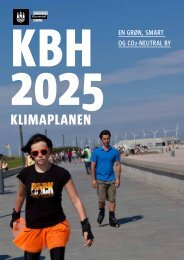
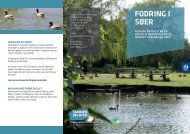
![Lokalplan 301[1] - Itera](https://img.yumpu.com/49288321/1/184x260/lokalplan-3011-itera.jpg?quality=85)
